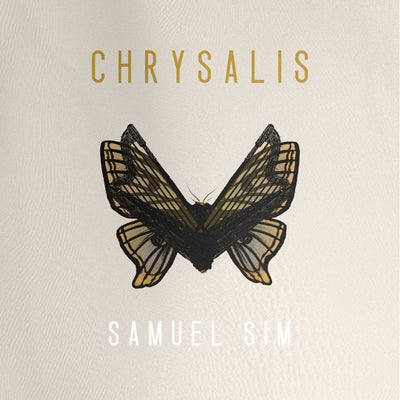
Inspirational warped harp sounds
- You can buy now and download any time
Listen to Samuel Sim — Chrysalis
Dusky-Wing - Oliver Patrice Weder
Eufala - Oliver Patrice Weder
Imago - Oliver Patrice Weder
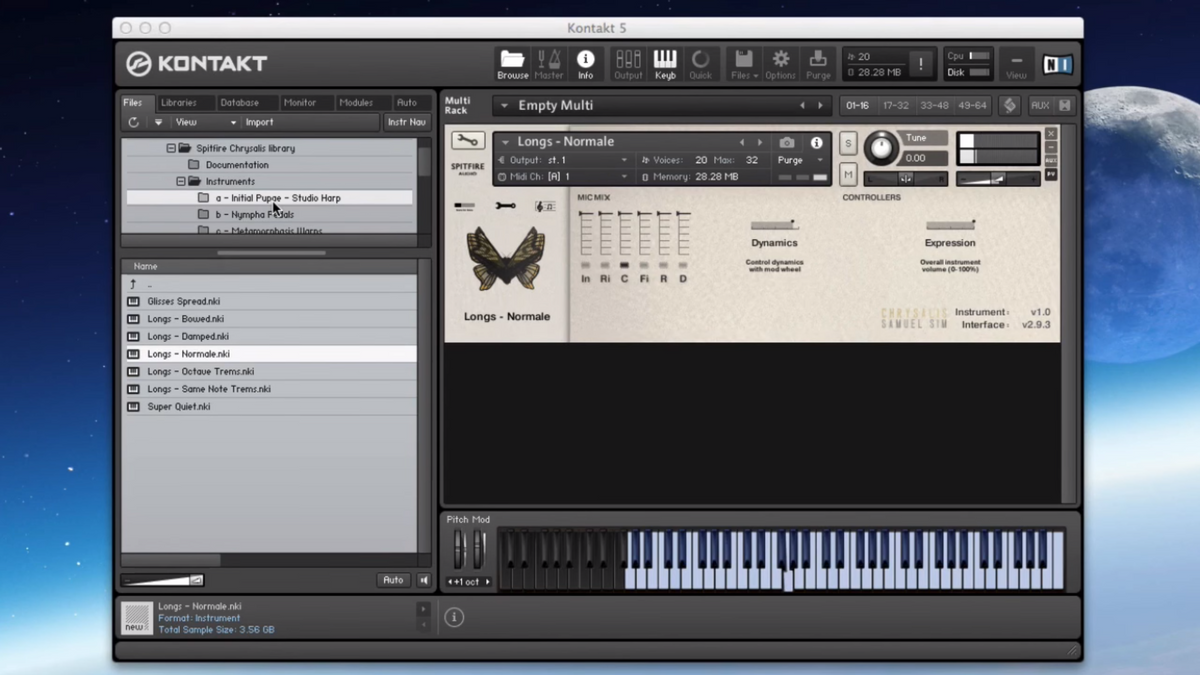
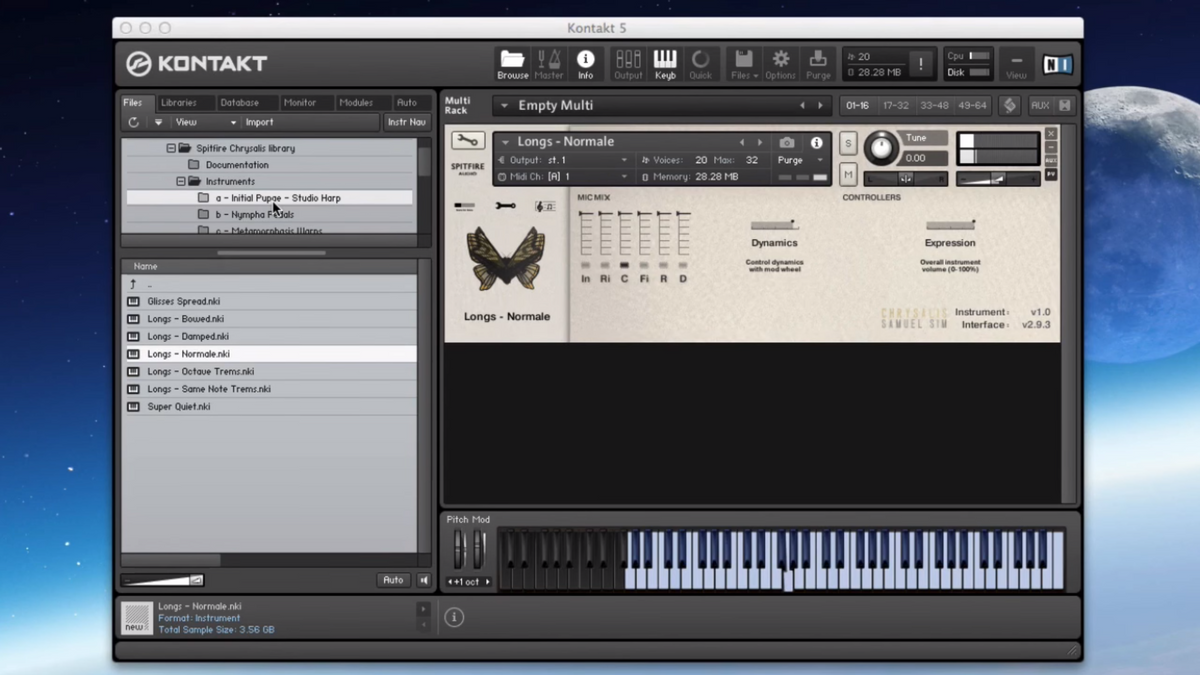
Walkthrough
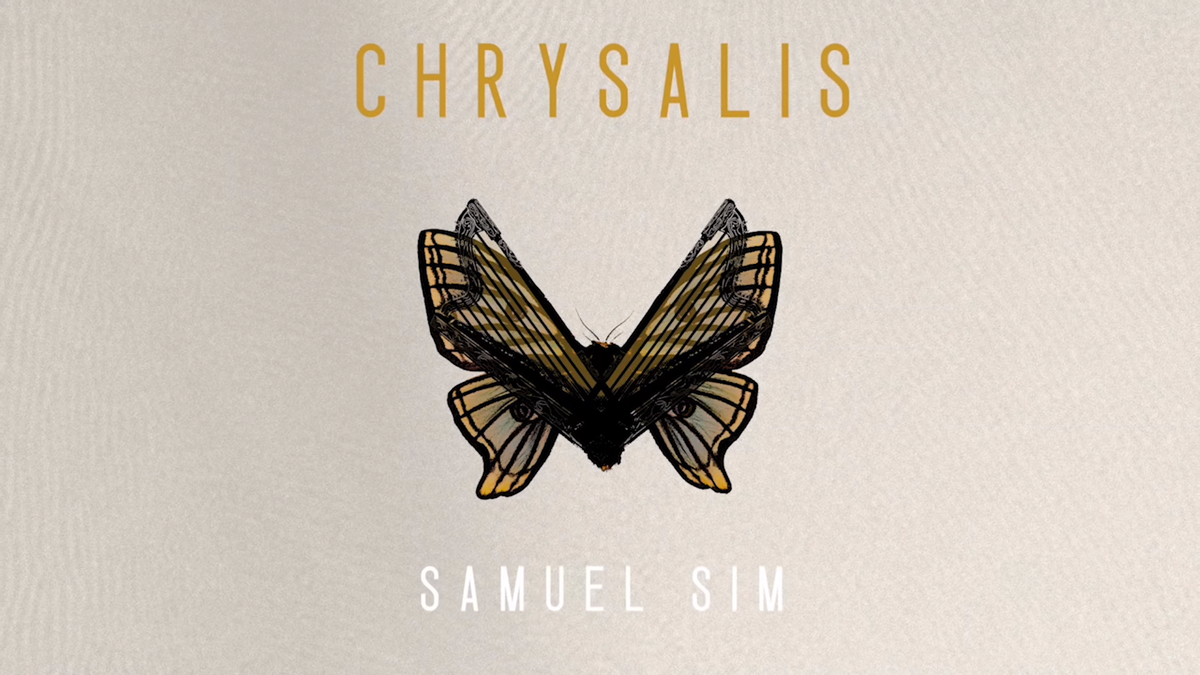
In Conversation with Samuel Sim
Overview
Samuel is one of the busiest composers working in London today. The ferocious pace at which he works exposes the quality and drawbacks of the tools he uses. Chrysalis is a collection of tools and sounds based on Samuel pondering "what if..." and by analysing why he returned to some tools and not others. By grappling with the increasing demands of TV and film execs to reinvent the wheel and create something 'totally new' Samuel like many of us struggles with the concept of unfamiliarly familiar. It is the latter point that crystallised the core concept of the project.
To create something that could be used like a piano, but wasn't a piano; that projected like a harp, but didn't have the classical baggage; that played like a guitar, but without the folky, geocentric or ethnic connotation. So at the heart of the library is a beautifully performed and deep sampled harp played by the man himself. Alongside additional techniques are 'impossible' techniques. Bending strings beyond comprehension in order to bow adjacent
strings as a mere example. Samuel also played some very interesting and modern styles that experience has led him to believe is the way to make a workhorse set of tools.
Samuel also played through an array of awesome FX pedals and processing, delivering a barely recognisable and very edgy set of sounds. Spitfire and Samuel then took all of this rich and raw material and bent it out of comprehensive shape into some of the freshest sounds both Samuel and the Spitfire team has ever heard. The final piece of the jigsaw was a process of curation to combine sounds into an instantly gratifying set of instruments that only a man of Samuel's experience would know how to put together! In what Samuel described as "2am instruments" his aim was to create some presets that would allow you, when at your whits end in the early hours of the morning, to write, produce and complete a cue in realtime before you fall into an overworked slumber on the floor of your studio.
Background
Samuel Sim is part of the vibrant musical community at Tileyard Studios, North London. Alongside fellow TV & Film composers Dru Masters & Paul Thomson they often formed a discreet coterie of drinkers for "whine at five" sessions moaning about the state of the industry over a few glasses whilst the pop and dance contingent of Tileyard started their days work. These conversations became especially impassioned when talking about sampling, and it was only a matter of time before Sam and the Spitfire team started dreaming up a library of his very own. Following 4 years of pondering procrastination, experimentation and then weeks of slavish sampling, months of sound design the team and Sam can't quite believe that it's finally happened. But are proud that it surpasses everyone's expectations, born of bucolic and slightly slurred suggestions and protestations.
Samuel is widely considered to be one of the most exceptional musical talents of his generation. His beautifully evocative music and award winning film and television scores are fast making him one of the most sought-after composers working in the industry today. Early in his career, Samuel quickly stood out from the crowd with his award winning score for the BBC’s Dunkirk. A whirlwind success followed which soon saw him composing for the Hollywood feature film Awake. Most recently Samuel has scored ITV’s hugely successful TV drama Home Fires, C4’s drama The Mill (for which Samuel’s score received an Ivor Novello nomination), ITV’s Chasing Shadows, the touching ITV feature Father’s Day, and the Charlie Brooker/Daniel Maier comedy creation Touch Of Cloth. He also composed a wonderfully evocative score for the riveting STOP AT NOTHING: The Lance Armstrong Story.
Features
176 hand-sculpted sounds, organised into four distinct categories that follow the development of the library from an intimate harp, to a warped organic masterpiece.
Initial Pupae
Contains the pure harp sound, deep sampled with 6 different microphone options. It contains the 'typical' plucked harp sound normale, as well as a selection of atypical articulations, including all the strings resonating from a cello bow.
Metamorphosis Warps
23 different sounds, each with a single pluck and tremolo option. These each have two signals, combining the harp with an affected other.
The Cocoonase
100 sounds, again with two signals between the pure and the impure signal. The sounds in here are the softer side to Chrysalis, with luscious pads and ambiences.
Nympha Pedals
A selection of sounds created by amplifying the live harp through an coterie of pedals and into a Marshall JCM800. Each sound has 4 signals, so you can blend between the pure sound of the harp and the mesmerising soundscapes emanating from the amplifier, with different options for each.
The overview panel
This is the main interface for melodic instruments. Its default view displays all available playing techniques, has a simple microphone mixer and includes the main feature controllers.
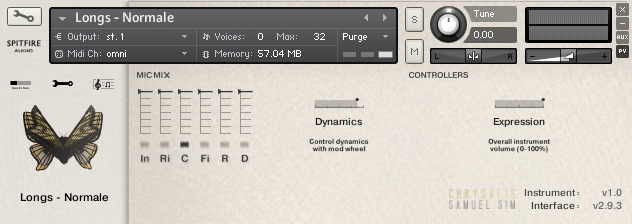
General controls panel
This view allows further in-depth control of the instrument, showing all available signals and feature controllers, as well as the ability to purge techniques from memory to reduce system usage.
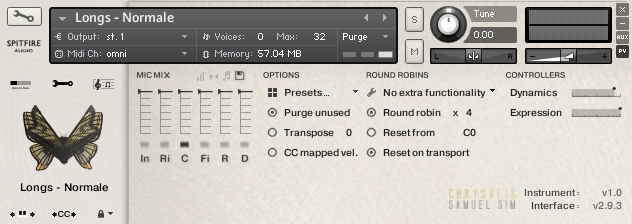
The Ostinatum
In this view you can add notes to a pattern sequencer, select which key it triggers on and then play for instant ostinato creation. It’s like an arpeggiator on a synthesiser.
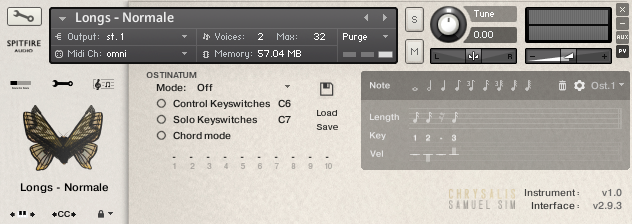
The Mercury Synth
This ingenious user interface features a range of organic sounds and specially curated warped sounds. All of the controls are assignable to your control surface, giving you the ability to instantly make our sounds your own.
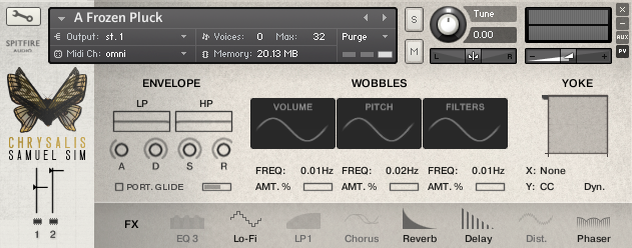
What's Included
Instruments
A - Initial pupae - studio harp
- Glisses spread
- Longs - bowed
- Longs - damped
- Longs - normale
- Longs - octave trems
- Longs - same note trems
- Super quiet
B - Nympha pedals
- Big sky trems
- Bloom pad (volume pedal)
- Bloom pad
- Cathedral twinkle
- Ebow
- Envelope delay gated
- Envelope delay
- Huge bloom
- Kemper cathedral
- Large bloom
- Manipulated pog
- Pitched lo-fi
- Pog bloom - 8ve trems fast
- Pog bloom - 8ve trems slow
- Pog bloom
- Sharp pad
- Slow fast trems
- Super slow trems
- Trem scrapes
- Warped trems
C - Metamorphosis warps
- 007 harp - trems
- 007 harp
- Alone in the dark - trems
- Alone in the dark
- Cat is out of the bag - trems
- Cat is out of the bag
- Crazy harp pig - trems
- Crazy harp pig
- Crisp attack - trems
- Crisp attack
- Crystal rain - trems
- Crystal rain
- Dark hole - trems
- Dark hole
- Distorted mess - trems
- Distorted mess
- Distortion faery - trems
- Distortion faery
- Flippin hell - trems
- Flippin hell
- Gentle drops - trems
- Gentle drops
- Ghostly beauty - trems
- Ghostly beauty
- Goldfingers - trems
- Goldfingers
- Great wobble - trems
- Great wobble
- Harpelicious - trems
- Harpelicious
- Melancholy dreams - trems
- Melancholy dreams
- Ringmod fun - trems
- Ringmod fun
- Space wobble - trems
- Space wobble
- Swelling tail - trems
- Swelling tail
- Tumbleweeds delay - trems
- Tumbleweeds delay
- Turner arounder - trems
- Turner arounder
- Voice of alien - trems
- Voice of alien
- We got the funk - trems
- We got the funk
D - The cocoonase
- A frozen pluck - trems
- A frozen pluck
- Aquatic hug - trems
- Aquatic hug
- Bowed voices - trems
- Bowed voices
- Building space - trems
- Building space
- Cathedral lift - trems
- Cathedral lift
- Cavernous body - trems
- Cavernous body
- Ceramic plate spin - trem
- Ceramic plate spin
- Contemporary post drone - trems
- Contemporary post drone
- Detuned tails - trems
- Detuned tails
- Digital waves - trems
- Digital waves
- Disillusioned choir - trems
- Disillusioned choir
- Distorted warmth - trems
- Distorted warmth
- Edges of noise - trems
- Edges of noise
- Glittered whispers - trems
- Glittered whispers
- Going down - trems
- Going down
- Hail mary - trems
- Hail mary
- Harmonious resonance - trems
- Harmonious resonance
- Harp at bathtime - trems
- Harp at bathtime
- Harp saw - trems
- Harp saw
- Harp sustainer - trems
- Harp sustainer
- Increasing darkness - trems
- Increasing darkness
- Lake normale - trems
- Lake normale
- Late riser - trems
- Late riser
- Low digital pad - trems
- Low digital pad
- Low octave resonance - trems
- Low octave resonance
- Mystical lake - trems
- Mystical lake
- Organ harmonics - trems
- Organ harmonics
- Organic slow sine - trems
- Organic slow sine
- Passing scream - trems
- Passing scream
- Quite odd - trems
- Quite odd
- Quite slowly - trems
- Quite slowly
- Repeteted - trems
- Repeteted
- Reverse angel bow - trems
- Reverse angel bow
- Scraped ambience - trems
- Scraped ambience
- Sink gurgle - trems
- Sink gurgle
- Slapback strings - trems
- Slapback strings
- Slow filler - trems
- Slow filler
- Space bow - trem
- Space bow
- Sub current swells - trems
- Sub current swells
- Suspense builder - trems
- Suspense builder
- The tables have turned - trems
- The tables have turned
- Tv 60s lasers - trems
- Tv 60s lasers
- Twinkles in the sky - trems
- Twinkles in the sky
- Underwater bypass - trems
- Underwater bypass
- Voices in waves - trems
- Voices in waves
- Wet bells - trems
- Wet bells
- Width wobbler - trems
- Width wobbler
- Witness this - trems
- Witness this
- Wonderous reveal - trems
- Wonderous reveal
- Wrap around - trems
- Wrap around
Mics & mixes
Initial pupae
- In - Inside soundboard
- Ri - Ribbon pair
- C - Condenser pair
- Fi - Mono ribbon on fingers
- R - Room
- D - Dirty mono
Nympha pedals
- 1 - Amplifier condenser
- 2 - Amplifier dynamic
- 3 - Inside soundboard
- 4 - Condenser pair
Metamorphosis warps and the cocoonase
- 1 - The harp
- 2 - The warp